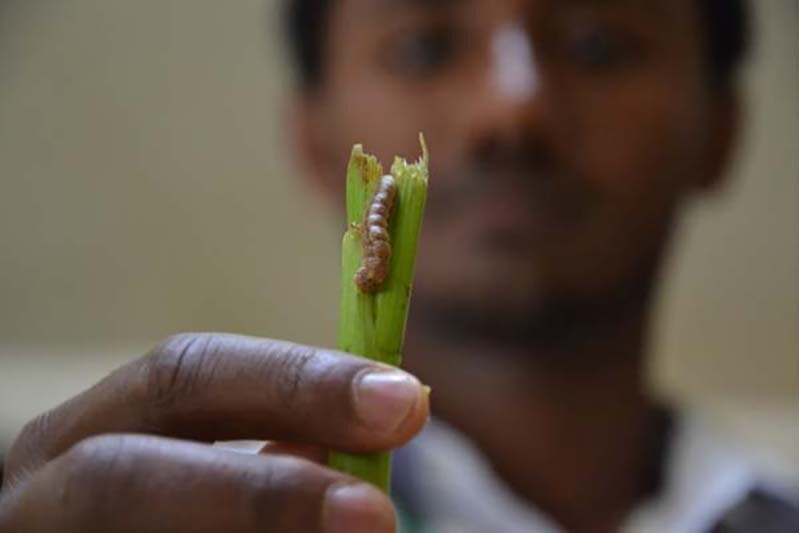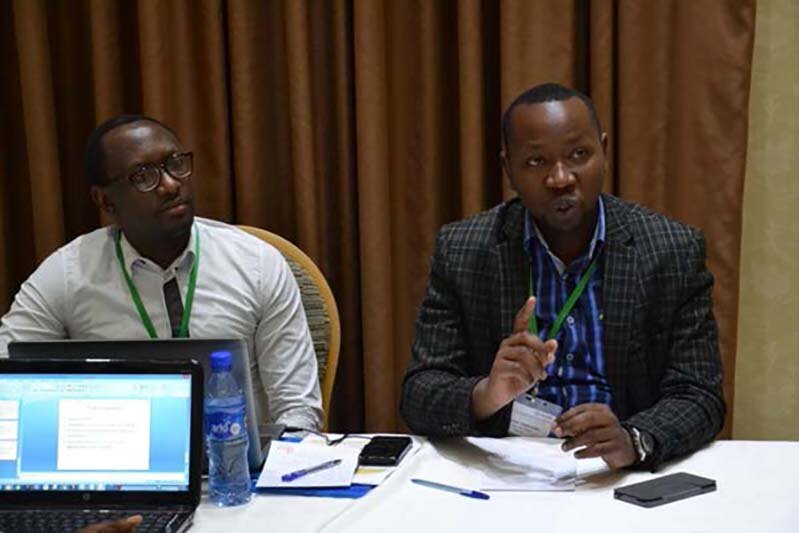Rwanda’s Nicolas Uwitonze was part of the country’s initial rapid response to the devastating invasive pest: The Fall Armyworm (Spodoptera frugiperda). In early 2017, Uwitonze was a staff member of Rwanda’s Agricultural and Animal Resources Development Board (RAB) in the Department of Crop Production and Food Security. Along with other extension agents, farmers, and community members, he entered the maize fields as part of a multi-district effort to mitigate the impact of the Fall Armyworm, manually picking off larvae and deploying pesticides. Now as an extension advisor to Feed the Future’s Rwanda Hinga Weze (“Grow the Harvest” in Kinyarwanda) activity, working with smallholder farmers, Uwitonze said that they are gearing up for a lengthy fight against the Fall Armyworm, “The Fall Armyworm is going to stay, so if you’ve done something last season and this season something is going to be done, you have to sit down and develop a long-term strategy for integrated pest management.” Pesticides should be used as a last resort, he urged.
Uwitonze and his Rwandan colleagues are not alone. The Fall Armyworm is ravaging maize fields across Africa. Since first appearing in Nigeria in January 2016, the pest has now surfaced in 29 countries across the continent, with Madagascar recently reporting its arrival. In six countries alone—Ethiopia, Ghana, Kenya, Nigeria, Zambia, and Zimbabwe—the pest has infested 1.5 million hectares of maize. According to B.M. Prasanna, Director of the International Maize and Wheat Improvement Center’s (CIMMYT) Global Maize Program, estimates that the Fall Armyworm could destroy between 8.4 and 20.6 million tons of maize valued at $2.5 and $6.1 billion per year.
With Africa Lead logistics and communications support, USAID-Washington’s Fall Armyworm Task Force and CIMMYT hosted a three-day training and awareness generation workshop in Addis Ababa, Ethiopia. Over 50 representatives from East Africa—including USAID officials, ministries of agriculture, Feed the Future implementers, private sector companies, non-governmental organizations, and other donor partners—attended. Stakeholders from Burundi, Kenya, Rwanda, Somalia, South Sudan, and Tanzania explored various approaches to integrated pest management of the Fall Armyworm, such as scouting, monitoring and surveillance, pheromone traps, biological control and encouraging natural enemies of the pest, host plant resistance, cultural control and sustainable agro-ecological management, and pesticide use risk management. This workshop was the second in a series of three regional training and awareness generation events organized by the Task Force and CIMMYT (Southern Africa, October 30-November 1 2017; Eastern Africa, November 13-15 2017; and West Africa in February 2018).

A stakeholder studies a sample species of the Fall Armyworm to strengthen identification skills. Photo credit: Africa Lead
“We’re here to turn you into plant doctors,” USAID’s Joe Huesing told training participants. Huesing is USAID’s senior biotechnology advisor on the Fall Armyworm Taskforce. “The good thing is there is a long history of treating this pest [in the US], and that’s where it gets complicated. You have to determine which approach to apply in the African agro-ecologies and smallholder farm situations.”
Technical experts from African Universities, USAID, CIMMYT, the International Institute of Tropical Agriculture (IITA), Center for Agriculture and Bioscience International (CABI), International Center of Insect Physiology and Ecology (ICIPE), private sector technology providers, and Michigan State and Oregon State Universities shared their expertise and facilitated discussions on integrated pest management at the farm level. Participants also provided firsthand experiences and feedback on suggested best practices for inclusion in the Fall Armyworm Pest Management Field Manual scheduled for release in December 2017.
“The added value of this training and workshop has been to help us think through how to do things better,” said Uwitonze. “It has helped us to understand there are environmental risks, human health risks associated to using pesticides. There are alternative means, integrated pest management practices and tools that we can look to make sure are provided to help control Fall Armyworm. We hope to train our program staff and help extension agents have this information on integrated pest management.”
